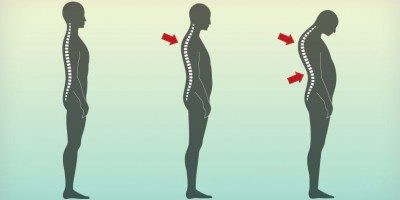Clinical Pilates for Kyphosis
The arrows emphasize the kyphosis. While the first image reflects a kyphosis of about 20 degrees, which is average, the third image reflects hyperkyphosis – when there’s a thoracic curvature of greater than 40 degrees
Kyphosis Is commonly known as having a “hunchback.” Kyphosis is an excessive outward curvature of the upper back and is most common in older women, often is related to osteoporosis. But it’s not just a women’s problem, men can have Kyphosis too. Some people experience back pain, neck pain, and stiffness. Kyphosis is a body posture that can become disfiguring. Sadly, with the increased number of hours that we’re sitting in front of our computers and ducking our heads forward to look at our cell phones, everyone is at a higher risk for developing Kyphosis with our poor posture habits! And just because you have Kyphosis, doesn’t mean you’ve got osteoporosis.
Age-related kyphosis affects up to 40% of adults over age 60. Characterised by a Cobb angle of kyphosis greater than 40°, this excessive forward curvature of the thoracic spine limits mobility. As the curvature increases, mechanical restrictions can impair respiratory function and balance, leading to issues such as pneumonia, falls and fractures and even depression caused by low-life satisfaction.
A promising study, ‘Age-related hyperkyphosis: update of its potential causes and clinical impacts-narrative review’ by Roghani et al, 2017, shows that targeted spine-strengthening exercises and posture training are effective rehabilitation modalities for decreasing hyperkyphosis in older adults. The study cites spinal extensor strengthening, spinal mobility exercises, and other posture-focused exercises as successful in reducing both radiographic and clinical measures of hyperkyphosis by up to 4°.
Clinical Pilates exercises develop a foundation of control, mobility and awareness; then build on that by varying position, load (gravity/body weight or resistance) and choreography to increase challenge and progress exercises with rehab management.
Goals of the exercises
- Strengthen spinal extensors and integrate into posterior slings/chains of the body
- Improve spinal mobility and stability
- Enhance postural awareness and control in a variety of positions, with gravity acting on the body in varying planes, with and without load
How can Pilates help Kyphosis? Dramatically! Yes, there might be underlying medical issues or a genetic predisposition to carry yourself with a hunchback. But ultimately developing better muscle function will help you stand taller. Exercise is crucial to develop better body alignment.
Pilates is one of the best physical activities on the planet to help eliminate hunchbacked, Kyphotic posture. Why? Because there is so much emphasis in a Pilates workout on moving the spine. By bending forward, backwards, sideways, and twisting the muscles of the torso in both the front and the back, the spine is getting stretched and strengthened in ways designed to help lift and lengthen it for better posture.
When the body is bent forward in Kyphosis, the upper back can become both over-stretched and weak while the chest muscles end up being too tight and strong. Added to this is the fact that 98% of what we do in life is in front of us – we’re ALL at risk for developing Kyphosis.
To begin re-balancing the upper body, the chest muscles need to be stretched and the upper back, arms and shoulders needs to be strengthened. Getting stronger with the hips, pelvic floor, and low core will also provide an anchor of support to help lift the spine into a taller position.
Why is Pilates a great way to help kyphosis? So many Pilates exercises are done flat on the back – and lying on your back can be a great way to let gravity start opening the chest and straightening out the spine. Movement of the spinal joints will help elongate the muscles. Every Pilates exercise is a combination of work and release. And Pilates exercises focus on both stability and movement. This is key in alleviating back pain and improving Kyphosis.
If you think the Pilates Roll down is making your Kyphosis worse, you’re wrong. Rolling DOWN is helping to strengthen both the abs and the back. As you lay each segment of your back on the mat one-by-one, you are helping to reinforce taller posture! It’s all about sequential, segmental, articulation of the spine. If your upper back is stuck like a chunk the segments cannot move freely. Pilates is designed to help free up the body for better movement.
The Pilates breaststroke prep exercise is a great way to open the chest by strengthening the upper back. If you don’t lift too much with your head and low back, you can begin to activate the middle-upper back muscles which is where the hump is.
Side bending and twisting exercises are the other two ranges of movement that are needed to help improve posture and reduce the exaggerated curve of Kyphosis. And both side bending and twisting exercises are excellent ways to begin mobilizing the mid to upper back for better posture to reduce the excessive outward curvature of Kyphosis. But as with any exercise, it might be challenging to get the parts of the back that really need to be moving to do the work to twist and side bend for maximum benefit.
There isn’t one exercise that you must to do to help Kyphosis. But a better understanding that you can improve posture and re-educate your muscles to reduce problems caused by Kyphosis is important. When you improve strength, flexibility, and body support it is possible to improve your alignment and alleviate the aches and pains. Pilates can be a valuable part of your exercise program to help improve posture and reduce the severity of Kyphosis and its associated aches and pains.You don’t have to live with a hunchback. By improving your posture with Pilates, you can stand taller, and keep your spine moving in a more normal and natural way.
CLICK HERE TO BOOK AND APPOINTMENT


